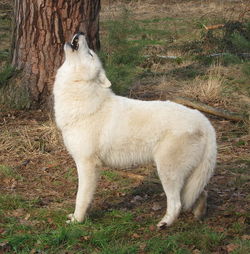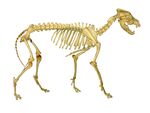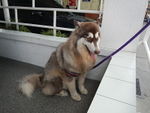Tundra wolf
| Tundra wolf |
|---|

|
| Scientific Classification |
| Binomial Name |
|
Canis lupus albus |
| Gray Wolf |
The Tundra wolf is a subspecies of the Grey Wolf (Canis lupas) that is native to Northern Eurasia (Asia and Europe). They are pack wolves that live in groups of about 30 individuals. The packs are dominated by an alpha male and a female who mate exclusively unless food is abundant. The pups will grow up inside a wolf den during that time and the alpha male will stand guard at the entrance of the den fending off any predators that would bring harm to the pups. The Tundra wolf's only known predator is man, but for the pups, eagles and bears might prey on them if they have the chance.
Body Design
Tundra wolves are among the largest of the grey wolf subspecies. Tundra Wolves can have a body length of 2 meters (7 feet) and usually an average weight of 45 – 57 kilograms (100 – 125 pounds)there have been some reports of wolves weighing 100 kilograms (200 pounds). Males are much larger than females. Most tundra wolves have a grey color, with mixes of black, rust and silver grey. Tundra wolves like most canids Tundra wolves have a high body, long legs, broad skull tapering to a narrow muzzle. Their tail is bushy and their coat has a thick, dense underfur.[1]A wolf has 22 teeth 12 incisors, 4 canines, 16 pre molars, and 10 carnassials and molars. The canines are the teeth used for grasping prey. Having strong jaws allows the wolf to crush bones to get to the soft marrow.
They can walk at about 4 miles (6.4 kilometers) per hour, but can reach speeds of 35 mph during a chase. Their usual mode of travel is to trot, which they do at various speeds, generally between 8 to 10 miles (12.8 to 16 kilometers) per hour. A wolf is very comfortable in the water, and does not hesitate to wade through icy streams or swim across short stretches of lake. The scent plays a very important role in the life of a wolf, by smell alone wolves can locate prey, other pack members or enemies. The distance at which any scent can be detected by a wolf is governed by atmospheric conditions but, even under the most favorable conditions , 1.75 miles denotes a particularly keen sense of smell.[2]
Life Cycle
Tundra wolves usually mate during late March to April due to their location. Only the dominant male and female will mate unless there is enough food for additional litters. If there is not enough food for additional litters they will die.[3] The female will enter an estus period for about 2 weeks, and the gestation period for a tundra wolf is 63 days. The female will give birth to 4-6 pups and nurse them for 45 days. They can live up to 16 years in captivity, but in the wild they live up to 13 years.[1] Pups start playing when they are 3 weeks old when they grow older they use the skills that they used when playing with each other to hunt prey. They really learn to hunt when they are about 4-6 months old by accompanying the adults on hunting trips and observed the techniques the adults used when hunting.
The wolf pup development system begins at the Neonatal Period when they are born, they are blind with closed eyes, deaf with small ears, and a nose with little if any sense of smell but a good sense of taste and touch. When they are about 2 weeks old the Transitional Period starts at this time the pups eyes start to open begin to stand and walk, vocalizations include growls, whimpering and squeaks, first attempts at howling, and weigh 3.5 lbs. The Socialization Period begins when they are 3 weeks old, the pups start to appear outside of the den playing by the entrance, hearing improves significantly, start developing canines and premolar teeth. At 4 weeks they start growing adult hair around nose and eyes, dominance and play fighting begun. The next stage is the Juvenile Period which starts from 8-16 weeks and ends at 1-3 years, weaning complete, pups feed on food provided by adults, adult guard hair becomes apparent on body. Rapid Growth lasts from 14-27 weeks, they start weighing around 28-70 lbs, in 4-6 month milk teeth are replaced, winter fur becomes apparent and pup appearance is nearly indistinguishable from adults, and the pups begin to accompany adults on hunts. At the Period of Slow Growth the pups begin to travel with the pack, and start hunting actively. The final stage is Sexual Maturity at this time they can disperse from the pack, and they weigh about 60-100+ lbs.[1]
Ecology
Tundra wolves travel in packs of about 30. The packs very territorial and defends a 25 to 100 mile area. At any one time 5 – 20 percent of the wolf population may be dispersing individuals. Usually a wolf disperses to find an individual of the opposite sex, find a territory, and start a new pack. Some may join packs that are already formed. Their only habitat requirements are food and water. They feed on animals that travel in herds such as deer, elk, musk ox, caribou and moose. They aren't scavengers, they prefer prey that are healthy. They are mostly native to Northern Europe and Asia. The only predator that wolves really have are humans but there have rare reports of a wolf attacking individual wolves that aren't part of a pack. Any pup who is less aggressive than his or her brothers and sisters gets less food. If pups are too persistent in their begging for food, adult wolves may growl to warn them to stop. The adults may also leave the area in an attempt to avoid the pups. Wolves tend to make their dens in caves or hidden passages under trees because it is warm.[4]
In a normal den, the birthing chamber lies at the end of a tunnel that may be up to 15 feet long in soft soil. The den is often slightly elevated above the rest of the tunnel, and no den-lining material is used. Wolves will use abandoned dens of other animals, such as bear dens or a beaver dam. The entrance to the den is about 20 to 28 inches wide and 15 to 20 inches high. Dens may have two or more entrances, both of which are usually marked by a large pile of dirt. Den sites are often near a source of water, and are often elevated so that wolves can detect approaching enemies. The Alpha male is very protective of the den. He will often act as a decoy, leading predators (bears and even eagles may prey on a very your pup) away from the site. Wolves will also eat wild berries and other fruit as a minor part of their diet.[5]
Wolf-Dog Hybrids
Wolf hybrids can be very unpredictable and dangerous. They can be trained but when they get tired they just stop listening to their owner. They will often display dominance towards their human owners by showing aggression. Scent marking is a huge part of their natural instinct, never attempt to take an item away from a wolf hybrid as they can be extremely possessive and will put up a fight for items they believe to be theirs. Each wolf hybrid needs at least 1/2 acre of land to roam. It should be filled with stimulating items such as shelters, climbing rocks, logs, plants, etc. Permits are required to own a wolf hybrid if you don't have a permit the hybrid will be confiscated. Do not let children come into contact with the animals. Make sure the animals are properly enclosed at all times and spray and neuter the animals. Wolf hybrids don’t make good pets. In fact, they aren’t really pets at all. While some of them may have traits of the dogs we consider to be mans best friend we can’t forget that they are actually wild animals and need to be treated as such.[6]
Video
Video description here....
References
- ↑ 1.0 1.1 1.2 Tundra-Wolf "Animal Corner". Web. Last accessed January 24, 2016. Unknown author.
- ↑ [1] "Wolf Country". Web. Last accessed February 2, 2016. Unknown author.
- ↑ Biology-and-Behavior "International Wolf Center". Web. Last accessed January 24, 2016. Unknown author.
- ↑ The Tundra Wolf.[2]"Cosmosmith". Web. Last accessed January 24, 2016. Unknown author.
- ↑ [3] "Wolf Country". Web. Last accessed on February 2, 2016. Unknown author.
- ↑ [4]"Facts about Wolf Hybrids. Dog or Danger? ". Web. Last Accessed February 7, 2016.





